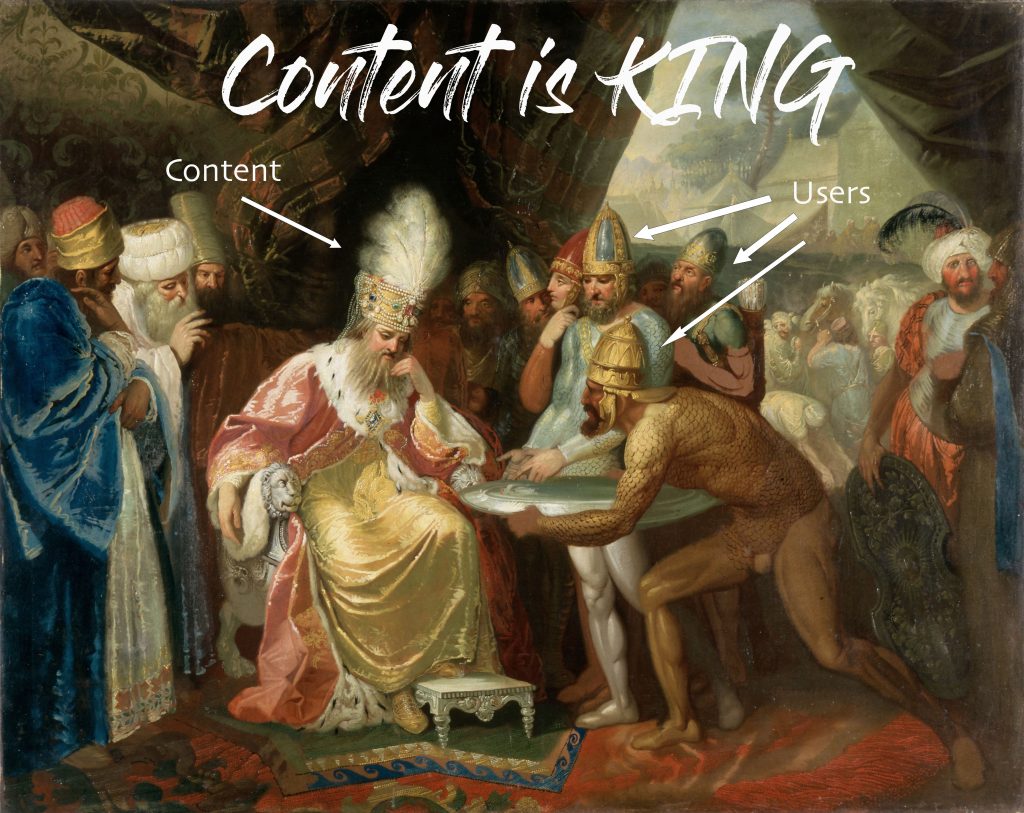Video Storytelling A Recipe for Success :
Videos with a Story, Why every video should have storytelling?
The basis of video marketing is: content is king – because without content there is no message. However, if you want to play in the Champions League of video marketing, you not only have to create content but also be a master of storytelling. Because texts alone are not touching – stories, on the other hand, are. They are the oldest form of emotional information exchange. After all, who doesn’t like to hear, read or tell a captivating story? Whether at a family dinner, in a pub among friends, or during a break with colleagues: We tell each other what we have experienced, what has moved us, motivated us, made us sad or strong. All of this creates a good story. And only the best of them are capable of inspiring so much that they are even retold – and that is the true art. So grab your paint and brush and we’ll take you on a journey to the land of storytelling.

Once upon a time… a definition: What is storytelling anyway? People have always told each other stories. To pass on knowledge, to share experiences, or to spread views. Nothing else is hidden behind the term storytelling.
Storytelling is the ability to tell a story – visual, auditory, or audiovisual – that captivates the listener, touches them emotionally, and thus leaves a lasting impression on them.
Wikipedia defines the term storytelling this way:
Storytelling is the social and cultural activity of sharing stories, sometimes with improvisation, theatrics or embellishment. Every culture has its own stories or narratives, which are shared as a means of entertainment, education, cultural preservation or instilling moral values. Crucial elements of stories and storytelling include plot, characters and narrative point of view. The term "storytelling" can refer specifically to oral storytelling but also broadly to techniques used in other media to unfold or disclose the narrative of a story.
https://en.wikipedia.org/wiki/Storytelling
Studies from brain research prove: We absorb information more readily the more senses are addressed when it is conveyed.
This applies not only to classic senses such as the eyes and ears but also to our hearts. A captivating narrator, a lively choice of words, deep emotions: All of this promotes our ability to remember what we have heard. And at best, it even encourages us to tell others about it.
So it’s no wonder that professional storytelling is also popular in marketing and advertising – including video marketing. After all, the ability to tell a story correctly is of crucial importance in communication. Fortunately, anyone can learn how to do it right – according to Christopher Bookers, there are seven simple patterns. We’ll explain what they are.
The hero’s journeys, monsters, and tragedies: storytelling by pattern In “The Seven Basic Plots: Why We Tell Stories,” Brooker explains that instead of crossing seven bridges, we need only know, relate, and adapt subsequent seven plots. These universal primordial stories, Brooker says, are found in all stories worldwide.
- Overcome the monster: It is the storytelling classic par excellence: good versus evil, rich versus poor, weak versus the strong. We all know at least one example of this storytelling pattern. Whether it’s Harry Potter’s eternal battle against Voldemort, Luke Skywalker’s against the dark force, or Peter Pan’s face-to-face with Captain Hook.
- From rags to riches This type of storytelling: usually stars an explorer and adventurer, plagued by a longing for more. This story is ideal, for example, if an image video is to be about the vision of a company or start-up. It reveals the evolution of the company, from the cornerstone through successes and setbacks to what the company is now.
- The search: It is the original theme in Storytelling: the search for a certain goal – this can be not only a place but also people, objects, or values. The hero usually has to go out into the wide, unknown world and encounters seemingly insurmountable obstacles and challenges, and eventually outgrows himself to overcome them.
- Journey and return: This storytelling pattern describes the classic hero’s journey: The protagonist has to find his way in a completely foreign world, solve the problems operating there and is only allowed to return to the familiar world after successfully managing the crisis. On this odyssey, he often leaves his old self behind to return as a hero. The (even name-giving) precedent: the adventurous wanderings of Odysseus according to Homer.
- Comedy: This storytelling type is also an extremely popular and much-used pattern in video marketing: because people like to laugh, especially at the expense of others. Wit and charm can be used to score points with the viewer. The characters are often confronted with a solvable conflict, which they master – often without even knowing it. In the end, there is a happy ending.
- Tragedy: Romeo and Juliet, Hamlet and Titanic: get out the handkerchiefs, it’s going to be tragic. The tragedy is the exact opposite of the “monster plot”: the story describes the downfall of the protagonist. In the process, the main conflict remains mostly unresolved. Bye-bye happy ending.
- Rebirth: Rebirth is the comeback, the return of the supposedly fallen hero, the new beginning. The rebirth story is used especially often in sports movies, in which the protagonists fight for their last big chance. Whether Rocky, Foxcatcher, or Blindside: the rebirth storyline promises drama, suspense, and likable loser types who mature into true heroes.
5 Visual Storytelling Rules You Should Know Generation Z is already one of the largest consumer groups and is waiting in the wings for many businesses and companies. Gen-Z doesn’t text – they communicate with emojis, snaps, and stories.
They no longer get their information primarily from Google, but directly from YouTube. Their lives are no longer written down in diaries but recorded as photos and selfies on Instagram. The whole thing even has a name: The phenomenon from text to image is called the ‘visual turn’. Reason enough to take a close look at the rules of visual storytelling. Here are five principles that will turn you into a storyteller:
1. pictures speak louder than words
In the spirit of the visual turn, let images speak for you and visually present the benefits of your company or product. In your storytelling video, it’s best to show someone who uses your product or service and benefits from it. Also, decent storytelling doesn’t necessarily require a lengthy story that spans minutes, hours, or weeks. On the contrary: it should be concise, catchy and understandable – and of course captivating.
2. storytelling does not equal fairy tale lesson
It has been psychologically proven: We find it easier to build relationships with people than with a brand or a company. So make a human being the protagonist of your video: This can be the CEO, an employee or a customer. Depending on the story you want to tell. The important thing is that the viewer can identify and compare with your hero. Make yourself tangible for your target group. But always remain honest. Because storytelling is not the same as telling fairy tales. Share a true, personal story with your target group that stays in their minds and sets you apart from your competition.
3. conflict is key
Conflict is the driving force of a story – because without conflict, there is no story. You will only become interesting for your target group if you manage to make your conflict tangible for them – and at best to speak from their soul.
4. behind the scenes
A successful video storytelling takes the viewer to secret places that would otherwise remain hidden. Take your target group behind the scenes of your company or your product.
5. extremely “meaningful”: sensory immersion
Images can not only activate our sense of sight, but also conjure up smells in our nostrils or virtually tickle our taste buds. It’s not for nothing that the “Food” category is one of the most popular on Instagram.
But other haptic materials such as paper, metal, water or earth in the picture can also appeal enormously to our senses.
Well? Getting your feet wet?
Success with stories: Video storytelling for companies
In marketing, nothing beats the impact of a good story. That’s why video storytelling has become a fixed component of a content strategy in recent years, including in video marketing. People don’t just want to be bombarded with advertising (anymore), they want to be entertained, informed, inspired and emotionally touched. What’s more, our brains love stories. People have been fascinated by stories for over 6,000 years, and we have been recording them in written form for 400 years. If you believe the neurologist Werner Fuchs, our brain does not react to facts, but to feelings. It has been proven that stories activate a particularly large number of areas in our brain and therefore stick better.
A well-told story takes us on an emotional journey that invites us to think, laugh, cry and, in any case, empathize. The rule here is that it’s not the one who shouts the loudest who is heard – honest, credible and emotional stories can score points, however. In addition, storytelling, especially with video content, is ideal for making complex topics and complicated content more tangible using examples, emotions and analogies.
Effective video storytelling also pays off for your company in the long run: It binds your target group emotionally to your brand. As soon as the viewer feels represented by the values shown or finds himself in the story, he begins to identify with your company.
Now all it takes is one click and your video has been liked, commented on or even shared. Really good content is not that which is consumed with pleasure – but that which is even retold.
Video Storytelling at its Best: Want some inspiration?
Video storytelling is a powerful tool for emotionally charging your video and making it interesting and comprehensible for the viewer – that much is clear. If your product or service manages to solve problems, unleash special features or convey an image in the context of a short story, then the message not only sticks in people’s minds longer, but also receives an entertaining added value.
And because you don’t always have to reinvent the wheel, here are three examples of successful video storytelling:
…and the moral of the story?
At the end of the day, in video storytelling is the technique that is responsible for the emotionalization and personification of your company and turns you from a stranger to a good friend with your own opinions, important messages and good advice for your potential customers.
Video storytelling in particular gives your product or brand a clear and unique added value, charges it with a positive image and transports the relevant emotions. The result: a “we” feeling that binds your consumers emotionally to your brand.
This is what makes video storytelling such a powerful technique that you should not do without when producing your marketing strategy.
Arty-Shock shows your STORY!
Video STORYTELLING is created in capital letters at Arty-Shock! A good story is the heart of every single film that comes from our heart. Our experienced concept designers and copywriters will develop the right storyline for your company! We are already bubbling over with ideas on how we could ideally stage your product or service.
Have we given you a taste for video marketing? Or are you looking for a professional video agency for your moving image project? Whether it’s an informative explainer video about your processes, a brilliant image film about your company, a 3D animation or your very own social media video production: we have the right answer for every video category. Let our video experts advise you on which type of video best suits your communication goal.







